
A | B | C | D | E | F | G | H | CH | I | J | K | L | M | N | O | P | Q | R | S | T | U | V | W | X | Y | Z | 0 | 1 | 2 | 3 | 4 | 5 | 6 | 7 | 8 | 9

The United States has 154 protected areas known as national forests, covering 188,336,179 acres (762,169 km2; 294,275 sq mi).[1] National forests are managed by the U.S. Forest Service, an agency of the U.S. Department of Agriculture.[2] The first national forest was established as the Yellowstone Park Timber and Land Reserve on March 30, 1891, then in the Department of the Interior. In 1897, the Organic Act provided purposes for which forest reserves could be established, including to reserve a supply of timber, protect the forest from development, and secure water supplies. With the Forest Reserve Act of 1891, the president of the United States is given the power to set aside forest reserves in the public domain. With the Transfer Act of 1905, forest reserves became part of the U.S. Department of Agriculture in the newly created U.S. Forest Service.[3][4]
By 1907, President Theodore Roosevelt had more than doubled the forest-reserve acreage, and Congress responded by limiting the president's ability to proclaim new reserves. The National Forest System underwent a major reorganization in 1908, and in 1911 Congress authorized new additions to the system under the authority of the Weeks Act. The management goals provided by the Organic Act were expanded upon by the Multiple-Use Sustained-Yield Act of 1960 to include "outdoor recreation, range, timber, watershed, and wildlife and fish purposes" as well as for the establishment of wilderness areas.[3][4]
As of September 30, 2014, the Forest Service manages a total of 192,922,127 acres (780,728.15 km2), 188,336,179 acres (762,169.48 km2) of which are national forests. The additional land areas include 20 national grasslands, 59 purchase units, 19 research and experimental areas, five land utilization projects and 37 other areas. The National Forest System has an extensive and complicated history of reorganization, so while there are currently 154 named national forests, many of these are managed together as either a single forest or separate forests.[1][4][5]
There is at least one national forest in all but ten states: Connecticut, Delaware, Hawaii, Iowa, Kansas, Maryland, Massachusetts, New Jersey, North Dakota, and Rhode Island (although Kansas and North Dakota have national grasslands). In addition, Puerto Rico contains El Yunque National Forest, the only tropical U.S. rainforest. Alaska has the most national forest land, with 21.9 million acres (8.9 million ha), followed by California (20.8 million acres, 8.4 million ha) and Idaho (20.4 million acres, 8.3 million ha). Idaho also has the greatest percent of its land in national forests, with 38.2 percent, followed by Oregon (24.7 percent) and Colorado (20.9 percent). On maps, national forests in the west generally show the true extent of their area, but those in the east often only show purchase districts, within which usually only a minority of the land is owned by the Forest Service.[1]
National forests
| NameA | Photo | Location[6]B | Date formed[4]C | Area[1] | DescriptionD |
|---|---|---|---|---|---|
| Allegheny | 
|
Pennsylvania 41°39′N 79°01′W / 41.650°N 79.017°W |
September 24, 1923 | 513,655 acres (2,078.7 km2) | Pennsylvania's only national forest includes Kinzua Dam and Allegheny Reservoir on the Allegheny Plateau in the northwestern part of the state. The forest contains the largest tract of remaining old-growth forest in Pennsylvania at Tionesta Scenic and Research Natural Areas and 10 mi (16 km) of the North Country Trail.[7][8]: 255–263 |
| Angeles | 
|
California 34°24′N 118°10′W / 34.400°N 118.167°W |
December 20, 1892[9] | 661,565 acres (2,677.3 km2) | Located in the San Gabriel Mountains at the edge of the Los Angeles metro area, this national forest includes five wilderness areas. Much of the forest is dense chaparral. Elevations in the forest range from 1,200 feet (370 m) to 10,064 feet (3,068 m) at the summit of Mount San Antonio.[10] |
| Angelina | 
|
Texas 31°13′N 94°17′W / 31.217°N 94.283°W |
October 13, 1936 | 154,140 acres (623.8 km2) | Primarily longleaf, loblolly, and shortleaf pine, the forest includes two wilderness areas and borders the Sam Rayburn Reservoir. The forest provides habitat for the endangered red-cockaded woodpecker and wintering habitat for bald eagles.[11][12]: 303–305 |
| Apache–Sitgreaves | 
|
Arizona, New Mexico 33°44′N 109°05′W / 33.733°N 109.083°W |
August 17, 1898 | 2,626,306 acres (10,628.3 km2) | Encompassing the Mogollon Rim and White Mountains, this forest includes 34 lakes and over 680 miles (1,090 km) of rivers and streams, more than any other national forest in the arid Southwest.[13] |
| Apalachicola | 
|
Florida 30°11′N 84°41′W / 30.183°N 84.683°W |
May 13, 1936 | 576,119 acres (2,331.5 km2) | As the largest national forest in Florida, Apalachicola includes over 2,700 acres (1,100 ha) of water and 67 mi (108 km) of the Florida Trail. There are caverns and sinkholes at the Leon Sinks Geological Area, while Fort Gadsden is along the Apalachicola River.[14] |
| Arapaho | 
|
Colorado 39°41′N 105°56′W / 39.683°N 105.933°W |
October 24, 1903 | 720,418 acres (2,915.4 km2) | Arapaho National Forest is in the high Rockies and includes six wilderness areas. It is currently managed jointly with Roosevelt National Forest and Pawnee National Grassland. The highest paved road in North America ascends Mount Blue Sky at an elevation of 14,265 ft (4,348 m).[15] |
| Ashley | 
|
Utah, Wyoming 40°38′N 110°06′W / 40.633°N 110.100°W |
July 1, 1908 | 1,378,424 acres (5,578.3 km2) | Ashley National Forest manages the Flaming Gorge National Recreation Area and the High Uintas Wilderness. Kings Peak at 13,528 ft (4,123 m) is the highest point in Utah and is located in the Uinta Mountains.[16] |
| Beaverhead–Deerlodge | 
|
Montana 45°30′N 113°00′W / 45.500°N 113.000°W |
July 1, 1908 | 3,362,638 acres (13,608.1 km2) | The largest national forest in Montana, it encompasses several mountain ranges of the Rocky Mountains. The forest includes the Anaconda–Pintler and Lee Metcalf wilderness areas and sections of the Continental Divide Trail and Nez Perce National Historic Trail.[17] |
| Bienville | 
|
Mississippi 32°16′N 89°30′W / 32.267°N 89.500°W |
June 15, 1936 | 180,251 acres (729.4 km2) | Located in central Mississippi, this forest includes several lakes and reservoirs and Harrell Prairie, the largest and least disturbed prairie in the state. Bienville Pines Scenic Area includes 189 acres (76 ha) of old-growth forest. It is managed collectively with Mississippi's five other national forests.[8]: 162–166 [18] |
| Bighorn | 
|
Wyoming 44°32′N 107°21′W / 44.533°N 107.350°W |
February 22, 1897 | 1,105,311 acres (4,473.0 km2) | In the Bighorn Mountains of north-central Wyoming, Bighorn National Forest has eight lodges, several reservoirs, and 1,500 mi (2,400 km) of trails. Elevation reach 13,167 ft (4,013 m) at Cloud Peak in the Cloud Peak Wilderness, which is also the location of the Cloud Peak Glacier.[19] |
| Bitterroot | 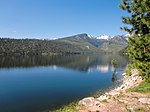
|
Montana, Idaho 45°46′N 114°17′W / 45.767°N 114.283°W |
February 22, 1897 | 1,594,579 acres (6,453.0 km2) | Bitterroot National Forest is located in the Bitterroot and Sapphire mountains, reaching its highest point at 10,157 ft (3,096 m) at Trapper Peak. The forest is named for the bitterroot plant.[12]: 192–199 [20] |
| Black Hills | 
|
South Dakota, Wyoming 44°00′N 103°47′W / 44.000°N 103.783°W |
February 22, 1897 | 1,250,866 acres (5,062.1 km2) | Consisting predominantly of Ponderosa pine, this forest is located in the namesake Black Hills. There are 11 reservoirs, 353 mi (568 km) of trails, and 1,300 mi (2,100 km) of streams in this forest. Black Elk Peak is the highest point in South Dakota and the highest point in the United States east of the Rocky Mountains at 7,244 ft (2,208 m).[12]: 293–301 [21] |
| Boise | 
|
Idaho 44°07′N 115°34′W / 44.117°N 115.567°W |
July 1, 1908 | 2,648,273 acres (10,717.2 km2) | Portions of the Boise, Payette, and South and Middle Forks of the Salmon River drainages make up the forest. There are over 7,600 mi (12,200 km) of streams and more than 250 lakes and reservoirs in the forest.[22] |
| Bridger–Teton | 
|
Wyoming 42°45′N 110°45′W / 42.750°N 110.750°W |
February 22, 1897 | 3,383,302 acres (13,691.7 km2) | As part of the Greater Yellowstone Ecosystem, Bridger–Teton National Forest has 27 glaciers in its portion of the Wind River Range. The Gros Ventre landslide formed a dam on the Gros Ventre River in 1925 before failing in 1927.[23] |
| Caribou–Targhee | 
|
Idaho, Wyoming 41°57′N 112°08′W / 41.950°N 112.133°W |
May 23, 1905 | 2,624,739 acres (10,621.9 km2) | The forest's Jedediah Smith Wilderness has many caves and the Winegar Hole Wilderness protects grizzly bear habitat in the Greater Yellowstone Ecosystem. The Upper and Lower Mesa Falls are on Henrys Fork of the Snake River and tours of Minnetonka Cave are available.[24] |
| Carson | 
|
New Mexico 36°30′N 106°04′W / 36.500°N 106.067°W |
November 7, 1906 | 1,486,372 acres (6,015.1 km2)[25] | In the Sangre de Cristo Mountains, this forest has over 600 mi (970 km) of trails and Taos Ski Valley. The highest point in the forest is Wheeler Peak, also New Mexico's highest point, at 13,161 ft (4,011 m).[12]: 246–253 [26][27] |
| Chattahoochee–Oconee | 
|
Georgia 34°45′N 84°07′W / 34.750°N 84.117°W |
July 9, 1936 | 866,763 acres (3,507.7 km2) | With 430 mi (690 km) of trails, this forest contains the southern terminius of the Appalachian Trail. Georgia's highest point, Brasstown Bald at 4,784 ft (1,458 m) is in the forest, and several Civil War battles were fought in the area.[8]: 56–70 [28] |
| Chequamegon–Nicolet | 
|
Wisconsin 46°02′N 90°48′W / 46.033°N 90.800°W |
March 2, 1933 | 1,523,704 acres (6,166.2 km2) | There are 2,020 lakes, 440 spring ponds, and 347,000 acres (140,000 ha) of wetlands in this national forest. There are also 493 mi (793 km) of non-motorized trails, 292 mi (470 km) of motorized trails, and 9,000 mi (14,000 km) of roads alongside five wilderness areas.[29] |
| Cherokee | 
|
Tennessee, North Carolina 35°52′N 83°03′W / 35.867°N 83.050°W |
June 14, 1920 | 656,394 acres (2,656.3 km2) | Cherokee National Forest has eleven wilderness areas, three large lakes, and over 600 mi (970 km) of trails, including 150 mi (240 km) of the Appalachian Trail in the Great Smoky Mountains. There are 43 mammal species, 154 fish species, 55 amphibian species, and 262 bird species in the forest.[30] |
| Chippewa | 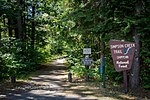
|
Minnesota 47°24′N 94°08′W / 47.400°N 94.133°W |
May 23, 1908 | 671,952 acres (2,719.3 km2) | With 1,300 lakes and ponds, 925 mi (1,489 km) of rivers, and 440,000 acres (180,000 ha) of wetlands, there are many opportunities for boating and fishing in this forest. There are over 180 nesting pairs of bald eagles as well as Canada lynx, and sandhill cranes here.[12]: 144–150 [31] |
| Chugach | 
|
Alaska 60°28′N 149°07′W / 60.467°N 149.117°W |
July 23, 1907 | 5,419,095 acres (21,930.3 km2) | As the third largest national forest, Chugach covers three unique landscapes: the Copper River Delta, Eastern Kenai Peninsula, and Prince William Sound. Many of the streams contain salmon and trout, and glaciers still carve the land here. Over half of the forest is tundra and glaciers.[32][33]: 2–9 |
| Cibola | 
|
New Mexico 34°20′N 107°35′W / 34.333°N 107.583°W |
November 6, 1906 | 1,616,435 acres (6,541.5 km2) | Part of this national forest are four wilderness areas, including the Sandia Mountain Wilderness east of Albuquerque. Elevations range from 5,000 ft (1,500 m) to 11,301 ft (3,445 m) at the summit of Mount Taylor, a stratovolcano in the San Mateo Mountains.[12]: 253–265 [34] |
| Clearwater | 
|
Idaho 46°33′N 115°09′W / 46.550°N 115.150°W |
July 1, 1908 | 1,682,068 acres (6,807.1 km2) | The forest covers the Bitterroot Mountains and Palouse Prairie as well as the Clearwater and Lochsa rivers. The Lewis and Clark Expedition followed the Lolo Trail through the forest in 1805, and gold miners came to the forest in the 1860s.[33]: 168–173 [35] |
| Cleveland | 
|
California 32°45′N 116°36′W / 32.750°N 116.600°W |
February 25, 1893 | 425,580 acres (1,722.3 km2) | In southern California, Cleveland National Forest has a Mediterranean climate and four wilderness areas. There are 22 endangered plant and animal species found in the forest. With its highest point at 6,271 ft (1,911 m) on Monument Peak, elevations are not as high here as in most of California's other national forests.[33]: 81–84 [36] |
| Coconino | 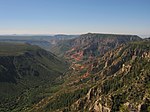
|
Arizona 34°45′N 111°33′W / 34.750°N 111.550°W |
August 17, 1898 | 1,852,201 acres (7,495.6 km2) | The San Francisco Peaks, Mogollon Rim, and Oak Creek Canyon can be found in Coconino National Forest. The forest's Sycamore Canyon is the second largest canyon in Arizona's redrock country. The forest also contains Humphreys Peak, which at 12,637 ft (3,852 m) is the highest point in Arizona.[33]: 28–37 [37] |
| Colville | 
|
Washington 48°32′N 117°54′W / 48.533°N 117.900°W |
March 1, 1907 | 954,668 acres (3,863.4 km2) | With 486 mi (782 km) of hiking trails, Colville National Forest has elevations that range up to 7,300 ft (2,200 m) in the Kettle River and Selkirk mountains. Part of the Salmo-Priest Wilderness is in the forest along with part of the Pacific Northwest National Scenic Trail.[38] |
| Conecuh | 
|
Alabama 31°05′N 86°38′W / 31.083°N 86.633°W |
July 17, 1936 | 83,983 acres (339.9 km2) | Managed together with Alabama's other national forests, Conecuh has two areas designated for recreation: Blue Lake and Open Pond. The dry, sandy uplands support longleaf pine forest, while bottomlands have sinkhole ponds, springs, and swamps.[8]: 2–8 [39] |
| Coronado | 
|
Arizona, New Mexico 32°30′N 110°40′W / 32.500°N 110.667°W |
April 11, 1902 | 1,718,945 acres (6,956.3 km2) | Covering the sky islands of the Southwest, Coronado National Forest also includes Mount Wrightson and the birding destination of Madera Canyon. There are eight wilderness areas in the forest as well as observatories on Mount Hopkins and Mount Lemmon[40] |
| Croatan | 
|
North Carolina 34°52′N 77°00′W / 34.867°N 77.000°W |
July 29, 1936 | 161,325 acres (652.9 km2) | The only coastal National Forest on the east coast, Croatan includes estuaries and pocosins. The forest is home to carnivorous plants such as the Venus flytrap and pitcher plant. Cedar Point is a recreation area at the mouth of the White Oak River.[8]: 214–222 [41] |
| Custer | 
|
Montana, South Dakota 45°30′N 106°00′W / 45.500°N 106.000°W |
March 2, 1907 | 1,189,465 acres (4,813.6 km2) | Custer National Forest includes the Beartooth Highway and the Capitol Rock and the Castles National Natural Landmarks. The forest's Absaroka–Beartooth Wilderness includes Granite Peak, the highest point in Montana at 12,807 ft (3,904 m).[42] |
| Daniel Boone | 
|
Kentucky 37°17′N 83°52′W / 37.283°N 83.867°W |
February 23, 1937 | 564,168 acres (2,283.1 km2) | Encompassing part of the Cumberland Plateau and Appalachian Mountains, Daniel Boone National Forest has two wilderness areas and several reservoirs. Scenic areas include Cumberland Falls, Red River Gorge, Yahoo Arch and many caves.[43] |
| Davy Crockett | 
|
Texas 31°18′N 95°06′W / 31.300°N 95.100°W |
October 13, 1936 | 161,140 acres (652.1 km2) | Located where the southeastern pine forests meet the blackland prairies of central Texas, Davy Crockett National Forest's Big Slough Wilderness consists primarily hardwood forest. A recreation area surrounds Ratcliff Lake, which covers 45 acres (18 ha).[12]: 310–312 [44] |
| Delta | 
|
Mississippi 32°45′N 90°46′W / 32.750°N 90.767°W |
January 12, 1961 | 62,109 acres (251.3 km2) | Delta National Forest contains the only bottomland hardwood forest in the National Forest System, located in the floodplain of the Mississippi River.[18] The forest includes the Green Ash-Overcup Oak-Sweetgum Research Natural Areas, which is a National Natural Landmark because it contains remnant bottomland old-growth forest.[8]: 167–172 [45] |
| Deschutes | 
|
Oregon 43°50′N 121°32′W / 43.833°N 121.533°W |
July 1, 1908 | 1,612,218 acres (6,524.4 km2) | On the east side of the Cascade Range, Deschutes National Forest includes Newberry National Volcanic Monument and five wilderness areas. Lava River Cave, at 5,211 ft (1,588 m) long, is Oregon's longest lava tube.[46] |
| De Soto | 
|
Mississippi 31°02′N 88°59′W / 31.033°N 88.983°W |
June 17, 1936 | 532,100 acres (2,153.3 km2) | De Soto National Forest contains Mississippi's only wilderness areas: Black Creek and Leaf River. The Black Creek and Tuxachanie National Recreation Trails provide 60 mi (97 km) of hiking opportunities. Black Creek has been designated a National Wild and Scenic River for 21 mi (34 km).[8]: 173–178 [18] |
| Dixie | 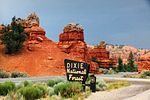
|
Utah 38°15′N 111°30′W / 38.250°N 111.500°W |
September 25, 1905 | 1,885,655 acres (7,631.0 km2) | Straddling the divide between the Great Basin and Colorado River, Dixie National Forest has elevations ranging from 2,800 ft (850 m) near St. George to 11,322 ft (3,451 m) on Boulder Mountain. Ashdown Gorge, Box-Death Hollow, Cottonwood Forest, and Pine Valley Mountain wilderness areas are in the forest.[47] |
| Eldorado | 
|
California 38°47′N 120°19′W / 38.783°N 120.317°W |
July 28, 1910 | 695,098 acres (2,813.0 km2) | In the Sierra Nevada, Eldorado National Forest has 611 mi (983 km) of fishable streams and 297 lakes and reservoirs. There are 349 mi (562 km) of trails and 2,367 mi (3,809 km) of roads in the forest. The forest's Desolation Wilderness is the most visited wilderness area per acre in the country.[33]: 84–88 [48] |
| El Yunque | 
|
Puerto Rico 18°17′N 65°48′W / 18.283°N 65.800°W |
January 17, 1903 | 28,683 acres (116.1 km2) | The only tropical rainforest in the National Forest System, higher elevations of El Yunque National Forest receive nearly 200 in (510 cm) of rainfall per year. There are 240 tree species in the forest, 23 of which are endemic to the forest, being found nowhere else in the world.[49][50] |
| Finger Lakes | 
|
New York 42°31′N 76°47′W / 42.517°N 76.783°W |
1983[51] | 16,352 acres (66.2 km2) | Located between Seneca and Cayuga lakes, Finger Lakes National Forest is one of the smallest national forests. The Gorge Trail enters a small gorge in the forest, and the North Country Trail crosses part of the forest.[8]: 209–212 [51] |
| Fishlake | 
|
Utah 38°42′N 111°57′W / 38.700°N 111.950°W |
February 10, 1899 | 1,452,969 acres (5,880.0 km2) | Located in south central Utah, Fishlake National Forest is named for Fish Lake, the state's largest natural mountain lake. The forest's Tushar Mountains reach their highest point at 12,174 ft (3,711 m) on Delano Peak. The forest is home to Pando, a clonal colony of an individual male quaking aspen determined to be the largest and most dense organism ever found.[33]: 284–288 [52] |
| Flathead | 
|
Montana 48°01′N 113°48′W / 48.017°N 113.800°W |
February 22, 1897 | 2,413,573 acres (9,767.4 km2) | Bordering Glacier National Park, Flathead is home to grizzly bears, bull trout, and Canada lynx. The forest manages four wilderness areas, including the Bob Marshall and Great Bear wildernesses.[12]: 203–208 [53] |
| Francis Marion | 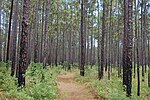
|
South Carolina 33°10′N 79°42′W / 33.167°N 79.700°W |
July 10, 1936 | 258,673 acres (1,046.8 km2) | Francis Marion National Forest is home to 150 mi (240 km) of streams and a variety of wildlife, including the endangered red-cockaded woodpecker. There are four wilderness areas in the forest, and it is managed together with Sumter National Forest.[8]: 282–289 [54] |
| Fremont–Winema | 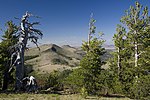
|
Oregon 42°34′N 120°52′W / 42.567°N 120.867°W |
September 17, 1906 | 2,253,796 acres (9,120.8 km2) | Encompassing the Warner Mountains and bordering Crater Lake National Park, Fremont–Winema National Forest also includes the semi-arid areas of the Oregon Outback. The Gearhart Mountain Wilderness is near the center of the forest.[33]: 217–220 [55] |
| Gallatin | 
|
Montana 45°15′N 111°00′W / 45.250°N 111.000°W |
February 10, 1899 | 1,849,701 acres (7,485.5 km2) | Bordering the north side of Yellowstone National Park, Gallatin National Forest contains parts of both the Absaroka–Beartooth and Lee Metcalf wilderness areas. Quake Lake was formed on the Madison River when an earthquake launched a landslide across the river in 1959.[56] |
| George Washington & Jefferson | 
|
Virginia, West Virginia, Kentucky 38°12′N 79°21′W / 38.200°N 79.350°W |
May 16, 1918 | 1,792,209 acres (7,252.8 km2) | In the Appalachian Mountains, the highest point of the forest is Mount Rogers, also the highest point in Virginia at 5,729 ft (1,746 m) in Mount Rogers National Recreation Area. There are 230,000 acres (93,000 ha) of old-growth forest here, and the Blue Ridge Parkway and Appalachian Trail both run through the forest.[57] |
| Gifford Pinchot | 
|
Washington 46°10′N 121°48′W / 46.167°N 121.800°W |
July 1, 1908 | 1,312,274 acres (5,310.6 km2) | Gifford Pinchot National Forest includes Mount St. Helens National Volcanic Monument and parts of seven wilderness areas. There are 1,475 mi (2,374 km) of trails and 4,104 mi (6,605 km) of roads in the forest.[58] |
| Gila | 
|
New Mexico 33°17′N 108°20′W / 33.283°N 108.333°W |
March 2, 1899 | 2,658,321 acres (10,757.8 km2) | The forest's Gila Wilderness was the world's first wilderness area and was proclaimed on June 3, 1924. The Catwalk National Recreation Trail travels up a narrow canyon for 1.1 mi (1.8 km) while following Whitewater Creek.[59] |
| Grand Mesa | 
|
Colorado 39°05′N 107°54′W / 39.083°N 107.900°W |
July 1, 1908 | 345,939 acres (1,400.0 km2) | In western Colorado, Grand Mesa National Forest covers part of Battlement Mesa and most of Grand Mesa, the largest flattop mountain in the world with an average elevation of 10,500 ft (3,200 m). There are over 300 lakes in the forest. It is managed together with Gunnison National Forest and Uncompahgre National Forest.[12]: 49–56 [60] |
| Green Mountain | 
|
Vermont 43°18′N 73°00′W / 43.300°N 73.000°W |
April 25, 1932 | 408,419 acres (1,652.8 km2) | In Vermont's Green Mountains, this forest includes eight wilderness areas. Among the 900 mi (1,400 km) of trails in the forest are the Appalachian Trail and two National Recreation Trails: Long and Robert Frost.[61] |
| Gunnison | 
|
Colorado 38°41′N 106°41′W / 38.683°N 106.683°W |
May 12, 1905 | 1,666,514 acres (6,744.1 km2) | Gunnison National Forest is located in the Rocky Mountains near Gunnison, Colorado. Among the seven wilderness areas in the forest are the Maroon Bells–Snowmass Wilderness. The Slumgullion Slide is a giant landslide due to the mineral montmorillonite.[12]: 56–67 [60] |
| Helena | 
|
Montana 46°33′N 112°12′W / 46.550°N 112.200°W |
April 12, 1906 | 982,385 acres (3,975.6 km2) | The Continental Divide Trail travels almost 80 mi (130 km) through the forest, which surrounds Montana's capital city. The Elkhorn Mountains are the only Wildlife Management unit in the National Forest System.[62] |
| Hiawatha | 
|
Michigan 46°10′N 86°40′W / 46.167°N 86.667°W |
January 16, 1931 | 898,475 acres (3,636.0 km2) | Located in Michigan's Upper Peninsula, Hiawatha National Forest borders Lake Superior, Lake Michigan, and Lake Huron. The forest is home to Grand Island National Recreation Area and five wilderness areas.[63] |
| Holly Springs | 
|
Mississippi 34°34′N 89°18′W / 34.567°N 89.300°W |
June 15, 1936 | 156,243 acres (632.3 km2) | In north-central Mississippi, Holly Springs National Forest has small lakes in upland forests and unique bottomlands. Chewalla and Puskus recreation areas surround the namesake lakes and have boat launches.[8]: 178–180 [18] |
| Homochitto | 
|
Mississippi 31°26′N 90°56′W / 31.433°N 90.933°W |
July 20, 1936 | 192,237 acres (778.0 km2) | Located in southern Mississippi, this forest is named for the Homochitto River, meaning "Big Red River." Most of the forest is densely forested hills, but there are recreation facilities at Pipes Lake, Clear Springs, and Mount Nebo.[8]: 180–186 [18] |
| Hoosier | 
|
Indiana 38°31′N 86°31′W / 38.517°N 86.517°W |
October 1, 1961 | 203,627 acres (824.0 km2) | The Pioneer Mothers Memorial Forest is 88 acres (36 ha) of old-growth forest in Hoosier National Forest. The forest's Charles C. Deam Wilderness is Indiana's only wilderness area.[64] |
| Humboldt–Toiyabe | 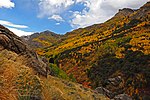
|
Nevada, California 40°23′N 115°33′W / 40.383°N 115.550°W |
May 3, 1906 | 6,290,945 acres (25,458.6 km2) | As the largest national forest outside of Alaska, Humboldt–Toiyabe occupies many of the mountains of Nevada's Basin and Range Province. Spring Mountains National Recreation Area is located near Las Vegas and is part of the forest.[65] |
| Huron–Manistee | 
|
Michigan 44°33′N 83°52′W / 44.550°N 83.867°W |
July 30, 1928 | 975,130 acres (3,946.2 km2) | Loda Lake National Wildflower Sanctuary is located around a small spring-fed lake in the forest. The Nordhouse Dunes Wilderness has sand dunes up to 140 ft (43 m) high along Lake Michigan.[66] |
| Idaho Panhandle Coeur d'Alene, St. Joe, Kaniksu |

|
Idaho, Montana, Washington 47°43′N 116°13′W / 47.717°N 116.217°W |
November 6, 1906 | 3,074,438 acres (12,441.8 km2) | There are two wilderness areas, Cabinet Mountains and Salmo-Priest, and numerous recreation opportunities in Idaho Panhandle National Forest. This forest ranges from the Canada–US border to the Saint Joe River, which is the highest navigable river in the world.[33]: 173–179 [67] |
| Inyo | 
|
California, Nevada 37°30′N 118°39′W / 37.500°N 118.650°W |
May 25, 1907 | 1,957,264 acres (7,920.8 km2) | Located in the Sierra Nevada, Inyo includes Mono Lake, bristlecone pines, the Long Valley Caldera, nine wilderness areas, and Mount Whitney, which at 14,505 ft (4,421 m) is the highest point in the United States outside of Alaska.[68] |
| Kaibab | 
|
Arizona 35°56′N 112°09′W / 35.933°N 112.150°W |
July 1, 1908 | 1,561,060 acres (6,317.4 km2) | Located on the Colorado Plateau to both the north and south of Grand Canyon National Park, elevations in Kaibab National Forest reach 10,418 ft (3,175 m) on Kendrick Mountain in the Kendrick Mountain Wilderness. There are over 300 mi (480 km) of trails in the forest, including through the Kanab Creek Wilderness.[69] |
| Kisatchie | 
|
Louisiana 31°00′N 92°37′W / 31.000°N 92.617°W |
June 10, 1930 | 607,540 acres (2,458.6 km2) | Kisatchie is Louisiana's only national forest, covering old-growth pine forest and bald cypress groves in the bayous. There are 48 mammal species, 56 reptiles, 30 amphibians, and 155 breeding or overwintering birds in this forest.[70] |
| Klamath | 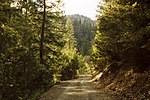
|
California, Oregon 41°30′N 123°08′W / 41.500°N 123.133°W |
Zdroj:https://en.wikipedia.org?pojem=List_of_national_forests_of_the_United_States
